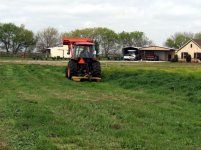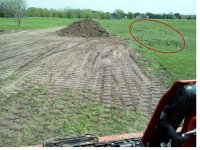You are using an out of date browser. It may not display this or other websites correctly.
You should upgrade or use an alternative browser.
You should upgrade or use an alternative browser.
RDrancher's Photo Thread
- Thread starter RDrancher
- Start date
- Views: 281157
More options
Who Replied?
/ RDrancher's Photo Thread
#311
kevin37b
Veteran Member
When you strip with the PR do you windrow and pick it up ? And those solenoids never worked either for us . The most useful feature , and it never worked . Great looking outfit you have , family , machinery , and customers .
RDrancher
Veteran Member
When you strip with the PR do you windrow and pick it up ? And those solenoids never worked either for us . The most useful feature , and it never worked . Great looking outfit you have , family , machinery , and customers .
Thank you Kevin. I took the left side end plate off the rake since it kinda naturally moves material that way, so I was able to windrow the grass and then pickup with the bucket. As far as I'm concerned the power rake is the most amazing attachment ever invented. Strip, rake, grade and make things look pretty too...amazing.
RDrancher
Veteran Member
Don't even try to walk on this bowl of jello. I don't know where the bottom is, but I was in over the tracks several times.
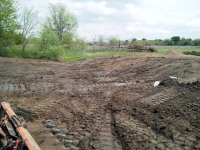
Graded out the exit end of the crossing, eliminated a couple of drainage berms and then spent an hour or so trying to clean the machine.


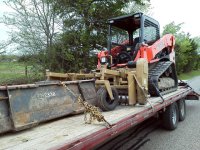
I just noticed in the culvert exit pic that you can still see brownish dirt from the rusty tractor axles and parts that I dug out.

Graded out the exit end of the crossing, eliminated a couple of drainage berms and then spent an hour or so trying to clean the machine.



I just noticed in the culvert exit pic that you can still see brownish dirt from the rusty tractor axles and parts that I dug out.
jinman
Rest in Peace
- Joined
- Feb 23, 2001
- Messages
- 21,059
- Location
- Texas - Wise County - Sunset
- Tractor
- NHTC45D, NH LB75B, Ford Jubilee
RDrancher
Veteran Member
I see your clients have plenty of the "Texas Broadleaf Grass" in their pasture.:laughing:
Only to be exceeded by ornamental honey locusts.
MRSDOUGLAS
Bronze Member
I see your clients have plenty of the "Texas Broadleaf Grass" in their pasture.:laughing:
<img src="http://www.tractorbynet.com/forums/attachment.php?attachmentid=313675"/>
You haven't seen the worst of it! The Noble Foundation said if we start treating it now we might kill it off in a couple of years! Any recommendations are welcome!
jinman
Rest in Peace
- Joined
- Feb 23, 2001
- Messages
- 21,059
- Location
- Texas - Wise County - Sunset
- Tractor
- NHTC45D, NH LB75B, Ford Jubilee
You haven't seen the worst of it! The Noble Foundation said if we start treating it now we might kill it off in a couple of years! Any recommendations are welcome!
I think your best bet is to grub it up by the roots, pile it up, and burn it. I've seen some places between Decatur and Fort Worth that are almost solid pricklypear. I have it on my place, but not a lot, probably less than 20 plants on 22 acres. I have a burner that you attach to a propane tank and I think I'll give that a try this summer with my grandson. He loves anything that goes bang, explodes, or burns. Cooking the cactii should be a great job for him.
RDrancher
Veteran Member
Grub it and burn it, burn it in place and then grub the roots, or spray it with Tordon or Remedy and diesel. The end result is the same...its a two to three year battle, sometimes even more. Any little pieces left over will start a new plant, so it pays to be thorough when cleaning it up. Don't bother trying to use gloves (even welding gloves) for pickup. Just pull up to it with the loader bucket and rake it in with a garden rake.
RDrancher
Veteran Member
I pulled off the jello bowl job last week with rain on the horizon. I figured it wasn't worth it to try to grade material that was pumping, even in the "dry" areas.
Then I did what I always do when I get antsy...I start another job. In this case...two "easy as pie" one-day, Saturday jobs. Both of them bit me in the hind quarters. Well actually, just one, but the other became quite a bit more involved.
I sent my father-in-law out with his L4240 to fill some depressions left from another contractors leach field install. It should have been an easy ten yard topsoil spread. About an hour later I get a call from him..."I'm buried up to my axles!" He had broken through the hard top layer of clay and found the jello below. He got out, but made quite a mess doing it. Not his fault...Texas clay can have a pretty steep learning curve! So I told him to head on home.
Meanwhile, I'm on a drainage re-grade next to a daylight garage. I knew that the job would also entail a bit of leaking wall investigation, but I never expected to find a 2x6 right in the middle of a concrete stem wall, hidden behind stone veneer and extending 36" below grade. Hmmm, I wonder why it leaks? After I removed some drywall in the garage, I found that not only had the contractor left a header form in the middle of the wall and covered up his mistake with stone. He also used the other side of the form as a stud to attach the drywall...jeez. I could see daylight next to the "stud" from the inside. The exposed "custom stud" is also full of termites. That made for a screeching halt to my part of the job for the time being. The new owner is also dealing with mold remediation on the other side of the house. The home was purchased in foreclosure from the previous owner...a local architect and builder. Double jeez!
After I removed some drywall in the garage, I found that not only had the contractor left a header form in the middle of the wall and covered up his mistake with stone. He also used the other side of the form as a stud to attach the drywall...jeez. I could see daylight next to the "stud" from the inside. The exposed "custom stud" is also full of termites. That made for a screeching halt to my part of the job for the time being. The new owner is also dealing with mold remediation on the other side of the house. The home was purchased in foreclosure from the previous owner...a local architect and builder. Double jeez!
So Saturday was not very productive for either one of the jobs and since the topsoil on the first job was blocking the customer's culvert, I decided I'd better try to make it work before the rain hit...that didn't.
Here's the result of a buried L4240...after he fixed it.
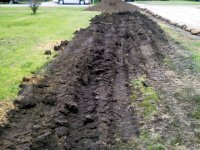
Here I am making smooth lumpy stuff out of bumpy lumpy stuff. A lot of work for a little topsoil. I'll go back and make it nice after the ground dries up.

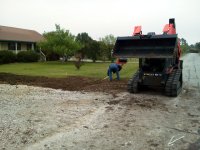
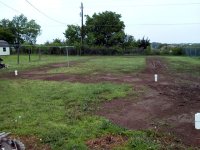
Here's the custom concrete / wood stem wall with the builder's version of waterproofing.
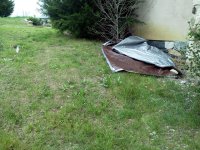
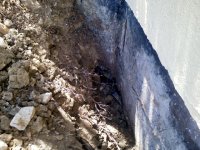

Every once in awhile I get a request from a customer to do a little out of the ordinary repair. This customer had paid two handy men to replace this water damaged siding and never saw either one of them again. With no contractors licenses required around here to maintain accountability and a level playing field, it's really a free for all. My FIL stripped off the damaged material and found that the sheeting had only been corner nailed. After securing the sheeting with screws along the edges and in the field, he put in a trim board as a break between the old and new siding, then caulked and painted the entire backside of the shop. Since the company that originally manufactured this particular siding has been out of business since 2007, he chose a suitable replacement. I think that it turned out nicely.
After securing the sheeting with screws along the edges and in the field, he put in a trim board as a break between the old and new siding, then caulked and painted the entire backside of the shop. Since the company that originally manufactured this particular siding has been out of business since 2007, he chose a suitable replacement. I think that it turned out nicely.

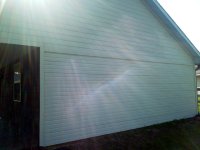
Then I did what I always do when I get antsy...I start another job. In this case...two "easy as pie" one-day, Saturday jobs. Both of them bit me in the hind quarters. Well actually, just one, but the other became quite a bit more involved.
I sent my father-in-law out with his L4240 to fill some depressions left from another contractors leach field install. It should have been an easy ten yard topsoil spread. About an hour later I get a call from him..."I'm buried up to my axles!" He had broken through the hard top layer of clay and found the jello below. He got out, but made quite a mess doing it. Not his fault...Texas clay can have a pretty steep learning curve! So I told him to head on home.
Meanwhile, I'm on a drainage re-grade next to a daylight garage. I knew that the job would also entail a bit of leaking wall investigation, but I never expected to find a 2x6 right in the middle of a concrete stem wall, hidden behind stone veneer and extending 36" below grade. Hmmm, I wonder why it leaks?
So Saturday was not very productive for either one of the jobs and since the topsoil on the first job was blocking the customer's culvert, I decided I'd better try to make it work before the rain hit...that didn't.
Here's the result of a buried L4240...after he fixed it.

Here I am making smooth lumpy stuff out of bumpy lumpy stuff. A lot of work for a little topsoil. I'll go back and make it nice after the ground dries up.



Here's the custom concrete / wood stem wall with the builder's version of waterproofing.



Every once in awhile I get a request from a customer to do a little out of the ordinary repair. This customer had paid two handy men to replace this water damaged siding and never saw either one of them again. With no contractors licenses required around here to maintain accountability and a level playing field, it's really a free for all. My FIL stripped off the damaged material and found that the sheeting had only been corner nailed.


Last edited:
